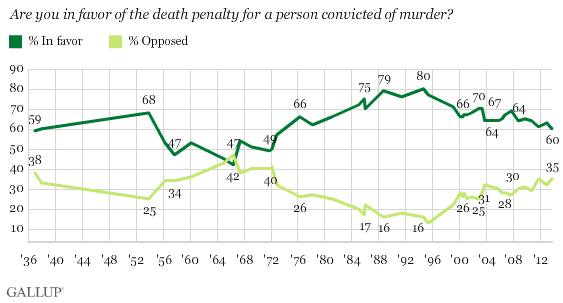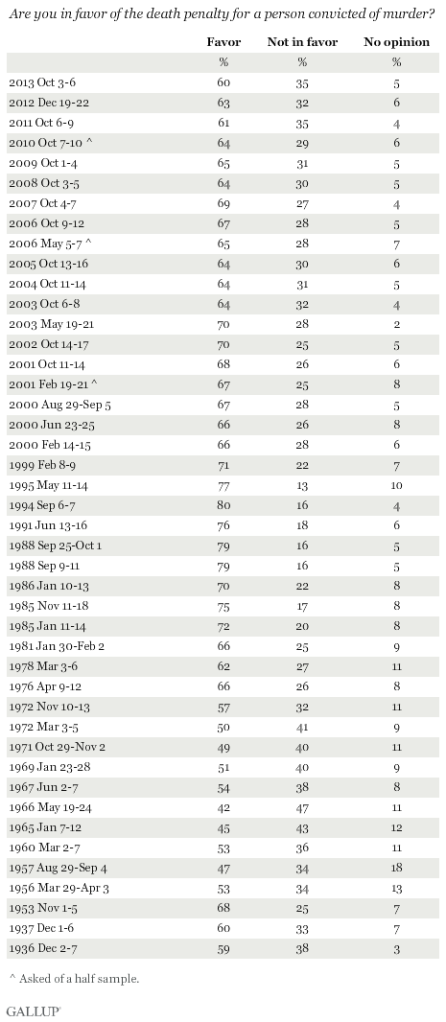How do Americans feel about the death penalty?
According to GALLUP, more Americans have been in favor of the death penalty than against it since the 1930s.
The only time U.S. residents were slightly more against capital punishment was in the late 1960s, according to GALLUP.
MORE: See the full study on the death penalty from GALLUP
Here’s a look at what you need to know about the death penalty in the United States.
Facts:
Capital punishment is legal in 32 U.S. states.
Approximately 3,095 inmates in 35 states are awaiting execution as of April.
Connecticut, Maryland and New Mexico have abolished the death penalty but it is not retroactive. Prisoners on death row in those states will still be executed.
Since 1976, when the death penalty was reinstated by the U.S. Supreme Court, 1,373 people have been executed. (as of March 2014)
Japan is the only industrial democracy besides the United States that has the death penalty.
Federal Government:
The U.S. government and U.S. military have approximately 64 people awaiting execution. (as of March 2014)
The U.S. government has executed three people since 1976. (as of March 2014)
Females:
There are approximately 61 women on death row in the United States. (as of March 2014)
Fourteen women have been executed since the reinstatement of the death penalty in 1976. (as of March 2014)
Juveniles:
March 1, 2005 – Roper v. Simmons. The Supreme Court rules that the execution of juveniles is unconstitutional. This means that 16 and 17-year-olds are ineligible for execution.
Twenty-two juveniles between the ages of 16 and 17 were executedbetween 1976 and 2005.
Clemency:
Clemency Processes around the Country
273 clemencies have been granted in the United States since 1976.
For federal death row inmates, the president alone has the power to grant a pardon.
Timeline:
1834 – Pennsylvania becomes the first state to move executions into correctional facilities, ending public executions.
1838 – Discretionary death penalty statutes are enacted in Tennessee.
1846 – Michigan becomes the first state to abolish the death penalty for all crimes except treason.
1890 – William Kemmler becomes the first person executed by electrocution.
1907-1917 – Nine states abolish the death penalty for all crimes or strictly limit it. By 1920, five of those states had reinstated it.
1924 – The use of cyanide gas is introduced as an execution method.
1930s – Executions reach the highest levels in American history, averaging 167 per year.
June 29, 1972 – Furman v. Georgia. The Supreme Court effectively voids 40 death penalty statutes and suspends the death penalty.
1976 – Gregg v. Georgia. The death penalty is reinstated.
January 17, 1977 – A ten-year moratorium on executions ends with the execution of Gary Gilmore by firing squad in Utah.
1977 – Oklahoma becomes the first state to adopt lethal injection as a means of execution.
December 7, 1982 – Charles Brooks becomes the first person executed by lethal injection.
1984 – Velma Barfield of North Carolina becomes the first woman executed since reinstatement of the death penalty.
1986 – Ford v. Wainwright. Execution of insane persons is banned.
1987 – McCleskey v. Kemp. Racial disparities are not recognized as a constitutional violation of “equal protection of the law” unless intentional racial discrimination against the defendant can be shown.
1988 – Thompson v. Oklahoma. Executions of offenders age 15 and younger at the time of their crimes are declared unconstitutional.
1989 – Stanford v. Kentucky, and Wilkins v. Missouri. The Eighth Amendment does not prohibit the death penalty for crimes committed at age sixteen or seventeen.
1994 – President Bill Clinton signs the Violent Crime Control and Law Enforcement Act that expands the federal death penalty.
1996 – Execution by firing squad is used for the last time in Utah. The last hanging takes place in Delaware.
January 31, 2000 – A moratorium on executions is declared by Illinois Governor George Ryan. Since 1976, Illinois is the first state to block executions.
2002 – Atkins v. Virginia. The Supreme Court rules that the execution of mentally retarded defendants violates the Eighth Amendment’s ban on cruel and unusual punishment.
January 2003 – Before leaving office, Governor George Ryan grants clemency to all of the remaining 167 inmates on Illinois’s death row, due to the flawed process that led to the death sentences.
June 2004 – New York’s death penalty law is declared unconstitutional by the state’s high court.
March 1, 2005 – Roper v. Simmons. The Supreme Court rules that the execution of juvenile killers is unconstitutional. The 5-4 decision tosses out the death sentence of a Missouri man who was 17-years-old when he murdered a St. Louis area woman in 1993.
December 2, 2005 – The execution of Kenneth Lee Boyd in North Carolina marks the 1,000th time the death penalty has been carried out since it was reinstated by the Supreme Court in 1976. Boyd, 57, is executed for the 1988 murders of his wife, Julie Curry Boyd, and father-in-law, Thomas Dillard Curry.
June 12, 2006 – The Supreme Court rules that death row inmates can challenge the use of lethal injection as a method of execution.
December 15, 2006 – Florida Governor Jeb Bush suspends the death penalty after the execution of prisoner Angel Diaz. Diaz had to be given two injections, and it took more than 30 minutes for him to die.
December 15, 2006 – Judge Jeremy Fogel of the U.S. District Court in San Jose rules that lethal injection in California violates the constitutional prohibition of cruel and unusual punishment.
December 17, 2007 – Governor Jon Corzine signs legislation banning the death penalty in New Jersey. The death sentences of eight men are commuted to life terms.
September 2007 – The U.S. Supreme Court takes up the case of Baze and Bowling v. Rees, in which two Kentucky death row inmates challenged Kentucky’s use of a three-drug mixture for death by lethal injection.
December 31, 2007 – Due to the de facto moratorium on executions, pending the Supreme Court’s ruling, only 42 people in the U.S. are executed in 2007. It is the lowest total in more than 10 years.
April 14, 2008 – In a 7-2 ruling, the Supreme Court upholds Kentucky’s use of lethal injection. Between September 2007, when the Court took on the case, and April 2008 no one was executed in the U.S.
March 18, 2009 – Governor Bill Richardson of New Mexico signs legislation repealing the death penalty in his state. His actions will not affect two prisoners currently on death row, Robert Fry, who killed a woman in 2000, and Tim Allen, who killed a 17-year-old girl in 1994.
November 13, 2009 – Ohio becomes the first state to switch to a method of lethal injection using a single drug, rather than the three-drug method used by other states.
March 9, 2011 – Illinois Gov. Pat Quinn announces that he has signed legislation eliminating the death penalty in his state, more than 10 years after the state halted executions.
March 16, 2011 – The Drug Enforcement Agency seizes Georgia’s supply of thiopental, over questions of where the state obtained the drug. U.S. manufacturer Hospira stopped producing the drug in 2009. The countries that still produce the drug do not allow it to be exported to the U.S. for use in lethal injections.
May 20, 2011 – The Georgia Department of Corrections announces that pentobarbital will be substituted for sodium thiopental in the three-drug lethal injection process.
July 2011 – Lundbeck Inc., the company that makes pentobarbital (brand name Nembutal), the drug used in lethal injections, announces it will restrict the use of its product from prisons carrying out capital punishment. “After much consideration, we have determined that a restricted distribution system is the most meaningful means through which we can restrict the misuse of Nembutal. While the company has never sold the product directly to prisons and therefore can’t make guarantees, we are confident that our new distribution program will play a substantial role in restricting prisons’ access to Nembutal for misuse as part of lethal injection.” Lundbeck also states that it “adamantly opposes the distressing misuse of our product in capital punishment.”
July 7, 2011 – Humberto Leal Garcia, Jr., a Mexican national, is executed by lethal injection, in Texas for the 1994 kidnap, rape and murder of Adra Sauceda in San Antonio. Despite pleas from the U.S. State Department and the White House, Texas Governor Rick Perry does not grant clemency and the U.S. Supreme Court does not intervene.
November 22, 2011 – Governor John Kitzhaber of Oregon grants a reprieve to Gary Haugen, who was scheduled to be executed December 6. Kitzhaber, a licensed physician, also puts a moratorium on all state executions for the remainder of his term in office.
April 25, 2012 – Connecticut Governor Dannel Malloy signs S.B. 280, An Act Revising the Penalty for Capital Felonies, into law. The law goes into effect immediately and replaces the death penalty with life without the possibility of parole. The law is not retroactive to those already on death row.
June 22, 2012 – The Arkansas Supreme Court strikes down the state’s execution law, calling the form of lethal injection the state uses unconstitutional.
August 7, 2012 – The Supreme Court allows the execution of Marvin Wilson, 54, a Texas inmate with low IQ.
November 6, 2012 – A measure to repeal the death penalty in California fails.
May 2, 2013 – Maryland’s governor signs a bill repealing the death penalty. The legislation goes into effect October 1.
June 26, 2013 – Texas executes its 500th prisoner since 1982, Kimberly McCarthy, for the 1997 murder of Dorothy Booth. McCarthy is the first female executed in the U.S. since 2010.
November 20, 2013 – Missouri executes white supremacist serial killer Joseph Paul Franklin for the 1977 murder of Gerald Gordon. He was blamed for 22 killings between 1977 and 1980.
January 16, 2014 – Ohio executes inmate Dennis McGuire with a new combination of drugs, due to the unavailability of drugs such as pentobarbital. The state used a combination of the drugs midazolam, a sedative, and the painkiller hydromorphone, according to the state corrections department. According to witness Alan Johnson of the Columbus Dispatch, the whole execution process took 24 minutes, and McGuire appeared to be gasping for air for 10 to 13 minutes.
February 11, 2014 – Washington Gov. Jay Inslee announces that he is issuing a moratorium on death penalty cases during his term in office.










































